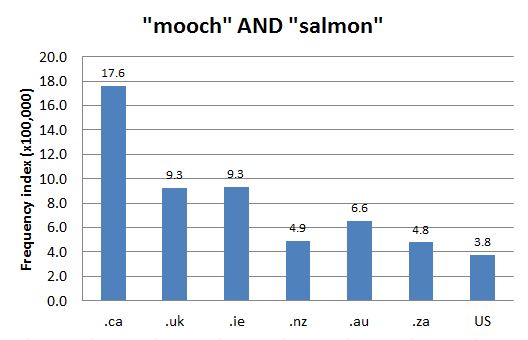DCHP-2
mooch ((2)) DCHP-2 (October 2016)
v. — Fishing, especially British Columbia & Washington State
to fish with a line with light tackle and live bait, usually herring, behind either a slow-moving or stationary boat.
Type: 5. Frequency — On the west coast of Canada and the US, mooch refers to a particular angling tactic. There are two types of mooching -- drift-mooching and motor-mooching. In drift-mooching the boat remains stationary and the line left to drift, only occasionally being reeled in to change the bait's depth. Motor-mooching involves putting the boat's motor in and out of gear to impart movement to the bait (see Rivers Inlet reference). Mooching is an alternative to the also-popular technique known as "trolling", in which the boat moves faster. Mooching is seen as one of the most effective fishing methods for catching salmon (see Haury 1947: 85), which accounts for its popularity in British Columbia.
The origin of mooch in this sense is unclear, though a legend says that Japanese fishermen initially developed the practice in the 1920s and blamed American fishermen for "mooching", or pilfering, their fishing technique (see Sitka or Bust reference). Though the term also appears in American English, particularly in the West, it is most frequent in Canada (see Chart 1).
See also Gage-3, s.v. "mooch", which is marked "Cdn.", and OED-3, s.v. "mooch" (v.7), which is marked "U.S. (west.) and Canad.".See also: mooch ((1)) mooched herring moocher mooching
References:
- Gage-3
- Haury (1947)
- OED-3 s.v. "mooch" Accessed 7 Apr. 2016
- Rivers Inlet "Fishing Technique" Accessed 7 Jul. 2014
- Sitka or Bust "Mooching for Salmon and Soaking for Halibut" Accessed 7 Jul. 2014
Images:
Chart 1: Internet Domain Search, 7 Jul. 2014
